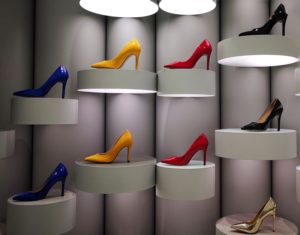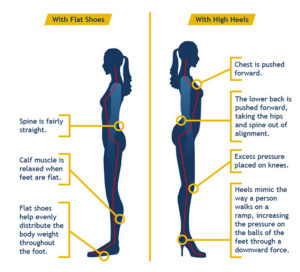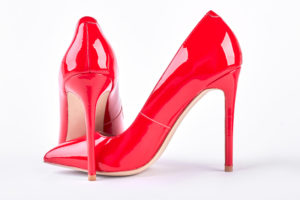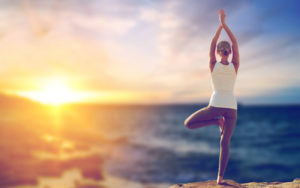To Heel or Not to Heel? Women and Our Shoes
Just last week, I happened upon an article in the July 20 edition of the DailyMail.com: “Sacré Bleu! Model Lauren Hutton, 75, FALLS OVER While Walking the Runway at Valentino’s Haute Couture Show in Paris after Tripping in Four-Inch Heels.”
I am not particularly fashion conscious. I certainly don’t follow the Haute Couture runways. Nor do I follow celebrity news. I don’t even read People magazine. So when this article caught my attention, I decided there must have been a reason.
 Why heels?
Why heels?
Could it be that I have always admired the beauty and imperfection of Lauren Hutton—the famous gap in her smile? Or could it be my interest in older women on runways of any sort? Maybe it was the gawker in me, the embarrassment factor of a women falling so prominently in public. (Why is falling in public so embarrassing?) Or maybe … the questions of heels and age and beauty and age and balance and age—all wrapped up into one.
I am happy to say that Hutton’s spill turned out to be non-eventful (unless you count the article in the DailyMail and the YouTube videos showing the fall). Hutton fell on her backside, was helped up by the model in a fluffy feathery get-up (Really??? Yes, really!) and continued the walk no worse for the wear. She was pictured later, barefoot and smiling in the grass. We can all breathe a sigh of relief! But … what about the other issues this piece of news raises—at least in my mind. What about those damned heels? About balance as we age? And what about beauty, attractiveness, and our willingness to sacrifice comfort and safety for a “sexier” look.
The Risks of Wearing Heels
I decided to check out “why heels?” And the answers I found are interesting to say the least. But first, lets get the physical ramifications of wearing heels out of the way—along with a warning to the wise: wear heels at your own risk!

So, what are the risks? We’ve all heard that wearing heels can cause physical damage. According to the Spine Health Institute
here are a few:
- The lower back pushes forward (along with the chest), which causes the hips and spine to be out of alignment. This leads to muscle overuse, fatigue, and pain—and changes in posture.
- Excess pressure is placed on the knees.
- Anatomical changes can actually result: calve muscles can shorten, tendons can thicken, and spondylolisthesis can also occur—the “slippage of one vertebra over another.”
- Foraminal stenosis and sciatica—both extremely painful nerve conditions—can also result.
- The downward force places undo pressure on the balls of the feet—the higher the heel, the greater the pressure.
Can Evolution Provide an Answer?
So, with all these common sense health (and pain) reasons to stop wearing heels why, why, why are we still choosing heels?
A Psychology Today article “Why High Heels Make Women More Attractive”
points to an evolutionary perspective—yes, an evolutionary explanation—for the popularity of high heeled shoes. High heels, the authors (both men—just saying) claim, emphasize the “female gait.” Their evidence comes from a study published in 2012 in the scientific journal Evolution and Human Behavior to support that claim.
A Test: Heels and Female Attractiveness
I decided to go straight to the source, pull up the journal article and have a look of my own. What I found in “High Heels as Supernormal Stimuli: How Wearing High Heels Affects Judgements of Female Attractiveness” by Paul H. Morris, et. al.
was quite interesting.
It seems that there are sex-specific differences in the way males and females walk: Men generally have longer strides and greater lateral sway in their upper bodies, while women have more movement in the hips, less “knee extension,” and use a greater number of steps to cover the same distance.
The authors of the study wanted to see if heels exaggerate these sex differences and, if so, whether people rating the various gaits would find the heel-walk more attractive.
The Point Light Display Method
 Morris and his colleagues hired 12 women “walkers” for this study: each walked on a treadmill, first in flat shoes and then in high heels. Study participants consisted of 15 men and 15 women who were tasked with comparing the different walks in terms of attractiveness.
Morris and his colleagues hired 12 women “walkers” for this study: each walked on a treadmill, first in flat shoes and then in high heels. Study participants consisted of 15 men and 15 women who were tasked with comparing the different walks in terms of attractiveness.
The researchers needed to isolate the heel-walk cues from other sex cues. In other words, they needed to make sure that study participants saw only the manner in which the walkers walked and no other sex-specific characteristics that might influence how the participants rated the different walks. To do this, the researchers used what’s known as the point-light display method.
Bright dots were placed on “key landmarks” on the walkers’ bodies. The study participants only saw the patterns of colored dots on a black screen—indicating the way the walkers walked—nothing else. Raters were not told the walkers’ sex or what type of shoes the walkers were wearing.
It seems strangely fascinating to me that viewers are able to identify a walker’s sex only from seeing a pattern of moving dots. It has been established in other point-light studies that people actually have 71% accuracy identifying a walker’s sex as long as it’s not from a side view. (The walkers in this study were shown walking head-on—toward the participants.)
Test Results and the “Female Gait”
Here are the results of the study: Of course, heels were found to exaggerate the “female gait.” When the walkers wore heels, they took “smaller more frequent steps, had less knee bend but had greater hip rotation and tilt.” (Anyone who’s ever worn heels could have told the researchers that! Heels=smaller steps. It’s a given.)
Next finding: When participants compared the flat-shoed gaits to the high-heeled gaits, the raters (both male and female) found the heel-walk more attractive.
In a second similar study, raters were asked to identify the sex of the walkers they viewed in point-light displays. Although all the walkers were women, raters believed that many of those wearing flats were men.
What does this all mean?
Super Releasers and “Supernormal Stimuli”
The researchers suggest that heels may be acting as what’s known as a “super releaser,” or an exaggerated female sex-specific factor that increases male arousal. This sort of thing is common in the wilder animal kingdom. “Exaggerated perineal swelling” in a female baboon (or “in layman’s terms a larger than normal swelling of the bottom associated with the sexually receptive period of their oestrous cycle”), for example, will increase arousal in male baboons. Maybe, seeing women in heels does the same thing for males of our species.
 So what? Let’s assume women in heels become “supernormal stimuli” and men go gaga at the sight of them. Why would women agree to be eye candy at the expense of their poor feet and backs? The evolutionary perspective would say that we women have our reasons: we want to increase our attractiveness to men to increase our own options for a suitable “mate.”
So what? Let’s assume women in heels become “supernormal stimuli” and men go gaga at the sight of them. Why would women agree to be eye candy at the expense of their poor feet and backs? The evolutionary perspective would say that we women have our reasons: we want to increase our attractiveness to men to increase our own options for a suitable “mate.”
Hmmm. Really?
The authors of the study do mention other fashion trends that don’t follow this evolutionary pull. Boxy shoulder pads, for example, “masculinize” female fashion and would thus fly in the face of this “supernormal stimuli” theory. Yet, examples such as exaggerated shoulders have been short-lived fads, while heels—exaggerating female sex-specific characteristics—have been a consistent, powerful draw over the ages.
Could there be something to this? Evolution-supported sex roles? It certainly seems possible. Biology, evolution, and culture can be a potent combination!
More Women are Choosing Comfort More of the Time
But … things may be changing. Women may finally be moving away from high-heeled fashions in favor of comfort—and health. According to an article in the Washington Post,
sales of high heels dropped 12 percent in 2017, while sales of women’s sneakers rose 37 percent during that time period to a whopping $2.3 billion!
This shift occurred in spite of a 28% rise in high-heel inventory and an availability of lower priced heels: “About one-third of high heels had been discounted by an average of 47 percent.”
Social expectations are changing when it comes to women’s shoes and shoe designers are jumping on the bandwagon. Marc Jacobs, for example, included “crystal embellished ballet flats” in a recent fashion show.
The Runway Fall as a Model’s Rite of Passage
While flat shoes are making an entry on the runway, unfortunately for Ms. Hutton, the outfit she modeled at Valentino’s Haute Couture show was accessorized with heels. And while runway falls are not uncommon (just google it and you’ll see lots of pictures and footage. Teen Vogue even calls the runway fall a modeling “rite of passage”) , it is not insignificant that Ms. Hutton is 75 years old.
As we get older, falling is more dangerous and healing (no pun intended) from falls becomes a slower process—just ask my old gynecologist who warned me that if I didn’t take meds for my osteoporosis, I would “fall, break my hip, and die.” Lovely! (I am not taking those meds, by the way—topic for another blog!)
Physical Balance and Age
 Maintaining physical balance can become an issue as we age, but there are some things we all can do to help with balance—some of which may be surprising.
Maintaining physical balance can become an issue as we age, but there are some things we all can do to help with balance—some of which may be surprising.
According to an article in Harvard Health Publishing “
Good Balance Requires Mental and Physical Fitness,” exercises specifically designed to improve balance as well as staying physically fit overall can prevent falls. But staying mentally active and maintaining brain health are also critical:
“’We need careful planning of our movements, decision making, reaction time, and attention,’ says Brad Manor, PhD, an instructor in medicine at Harvard Medical School and director of the Mobility and Falls Program at the Harvard-affiliated Hebrew SeniorLife in Boston. ‘Balance is a complex system. Especially as we get older, cognition becomes a big part of it.’”
The inner ear, our somatosensory system—the system that lets us feel the ground beneath us—and our vision are all important systems involved in balance, and all also rely on our thinking.
Mind-body exercises such as Tai Chi and yoga can help, as can just practicing standing on one leg for a short time each day (think the yoga pose “tree”). But strength is also needed should you lose your balance. The ability to right yourself quickly can be developed through basic strength training and “rapid, forceful exercises like hopping and side stepping.”
To Heel or Not to Heel?
So … to heel or not to heel is a question not unlike to dye or not to dye. While the attractiveness of heels may have an evolutionary basis, the decision whether to strap on stiletto sandals or to lace up a pair of Nikes is a personal one, grounded in our own ideas of beauty, confidence, and comfort.
Where do you stand on the question of heels, in general, and on heels in relation to age? How have your shoe habits changed over the years?
As always, I would love to hear your thoughts! Please leave a comment or send me an email. And remember, whatever you have on your feet, enjoy the journey!
Have a great week and see you next Friday!
Diane




Great, thought-provoking article!
Thanks, Leslie!!
Standing at 5’0″ tall, I wore heels for height, not sex appeal, since the age of 13 or 14. I didn’t wear my first pair of sneakers until my 30’s (gym class not included). I am testimony to shortened calve muscles and tendon scar tissue. For decades I couldn’t walk on flat feet. Even barefoot I walked as though I had on 4″ heels. I can finally walk on flat feet now, but continually work on trying to stretch out my calve muscles and alleviate lower back pain.
Wow, Denise. Thanks for sharing your experience: “I am testimony to shortened calve muscles and tendon scar tissue. For decades I couldn’t walk on flat feet. Even barefoot I walked as though I had on 4″ heels.” I imagine that wearing heels while still growing can make matters worse.
Hi Diane,
AMP partner here and lifelong runner. High heels are foot and back surgeons’ nightmares, but many women like them. Working for Blue Cross Blue Shield I.T. department in the 80s I was pressured into wearing heels. Like many office workers, I commuted in sneakers and reduced use. Having had foot surgery on both feet, one bunion and one toe fusion, I have bought from Amazon several pair of Joomra minimalist wide-toe box shoes for street use this year. They are NOT good for running as they provide no shock absorption and injure feet with stress fractures and more, hence so many minimalist running shoe law suits and the quick fading of that fad ten years ago).
Always loved Lauren Hutton, a real rebel in the modeling world and very successful. Very intelligent and interesting with quick wit, lived here in NM for a long time. Often photographed wearing slacks and comfortable, flat shoes. Hutton wearing heels at age 75 was a surprise!
It pains me to observe all straight female celebrities prancing onto talk shoes wearing stilettos, which, like long manicured nails, IMHO are symbols of female aggressions and weapons!
Do you see sprinters or ballet dancers wearing heels? There’s your answer to how heels impede movement.
Do men like them? Do you want a man who wants you to be an uncomfortable sex object? My father set a standard of ditching ties in his office when it was scandalous to be so “casually” dressed.
Heels? Just say no if you don’t like them.
Hair dye? Animal testing? Say no. Don’t like dyeing hair, don’t dye it. Like dyeing it, dye it –intentionally.
I remember during the 70s women’s’ movement when I was scorned for wearing makeup and being a clerical worker. That is “tyranny in reverse.” For that reason and due to some very abrasive and overbearing strident personalities, I was put off and quit the movement. It was not an inclusive movement.
We need to be careful as women in supporting individual choice. Being female is not “one size fits all.” Same with abortion, birth control, intentional childlessness, breast feeding: They are all CHOICES. What works for one woman does not work for another.
Thanks, Diana! There are so many important points here–I think most of all your thoughts about choice. Love “being female is not ‘one size fits all.'” Sometimes in our zealousness to “free” each other, we forget that “what works for one woman does not work for another.” Thanks so much for the reminder!
Hi Diane,
Very interesting post!
The last few years I have had trouble finding shoes that feel comfortable. I have a narrow foot so often the selection is minimal. I have discovered a couple of shoes that look fashionable and that I can wear for longer than ten minutes! I don’t even think of wearing heels any longer. I gave the last pair I purchased several years ago to a friend who loved them and wore them for a couple of years and passed them on to a younger woman who complemented her on them. I love thinking that those shoes that I loved (and wore perhaps twice) are making someone else happy. They weren’t very high but had a great look.
I am so grateful these days that my feet no longer hurt! I wear athletic shoes unabashedly and rejoice that I can walk! Last night, almost in anticipation of your post, I had a dream of walking with my mother who transitioned (died) in 1997. She had a lot of trouble walking after breaking her ankle in her forties. But in the dream she walked freely. I didn’t notice what type of shoes we were wearing!
Nicky–I love that the shoes you loved (and wore twice) are making the rounds–what a great use for them now! And I LOVE LOVE LOVE the dream! Thanks so much for sharing it!
How much I enjoyed this!!! I love the gap toothed, imperfect beauty of Lauren Hutton, too! I love the science + beauty in this, Diane!
Thank you, Janet! Embracing imperfection is my motto!